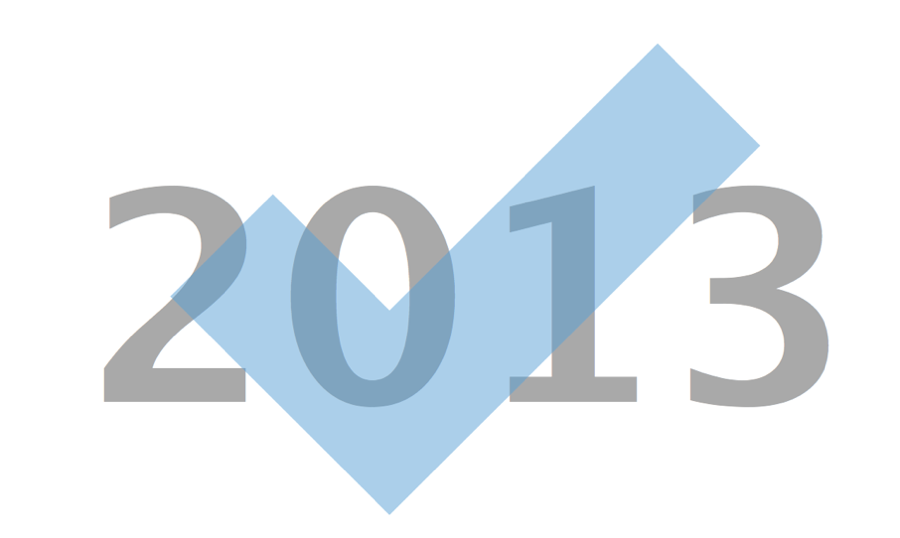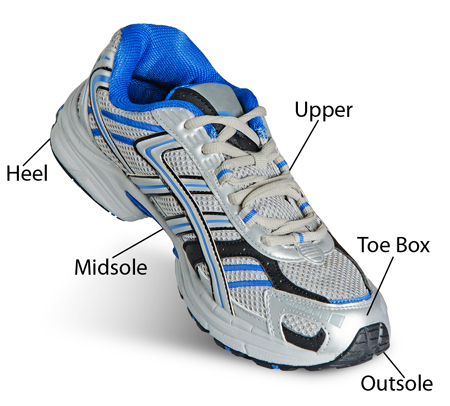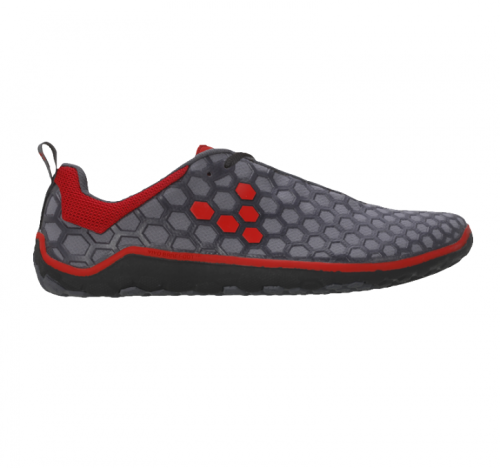
From now until 2013, we’re going to take a look at some New Year’s Resolutions and a Gear Diary way to help you keep them.
New Year Resolution: Get in Shape in 2013

It’s a new year and you’ve decided to make it a new you! So you’re really going to buckle down and get fit, but before you pick up a new gym membership or start downloading “Map My Run” to your iPhone, you need the right gear– starting with your feet. Even if you aren’t going to head out for a run, footwear matters. You need a good shoe for anything athletic, whether it’s a walk, a hike, the elliptical, or yes, heading out for a nice run. No matter what you do,when it comes to your feet it all starts with the right shoe.
We want to make sure you’re educated and prepared before you head to the running store or your local Foot Locker. If you don’t know a stability shoe from a neutral one, or can’t wrap your head around the idea of a “barefoot shoe”, don’t worry! Just keep reading for our athletic shoe cheat sheet!
Vocabulary:
Like any gear, there’s a whole new set of words and definitions to learn. It’s important to understand them, because there is a lot of marketing-speak out there, and buying the wrong shoes can lead to injury or at least discomfort. Being educated means you won’t be at the mercy of someone else’s advice, and it gives you the chance to ask the right questions instead of start with “Uh…what did you just say my feet do when I run?”
Pronation: this is the rolling motion your foot and ankle take when making contact with the ground while running or walking.
Over-pronation: Occurs if your foot or ankle rolls excessively inward during pronation.
Under-pronation (supination): Opposite of overpronation, where your foot and ankle roll outward.
Medial Post: This is a hard plastic piece that sits in the mid foot of a shoe and prevents overpronation.
Heel-to-toe drop: Measure of how high the heel of a shoe is versus the forefoot. Ex: a shoe may be 24mm high in the heel and 12mm high in the forefoot, giving it a heel-to-toe drop of 12mm.
Zero-drop: A shoe that has no heel-to-toe drop and is instead equidistant from the ground at both the heel and forefoot.
(Note: for visual learners, Running Warehouse has a great video about stack heights in shoes and what it means)
Forefoot strike: Landing on the front area of your foot and toes first, with your heel just touching down at the end of the motion.
Midfoot strike: Your midfoot comes into contact with the ground first.
Heel strike: The heel of your foot touches down first, and the toes come down last
(Note: again, the folks at Running Warehouse have a great video on this.)
(Image courtesy Dicks Sporting Goods)
Traditional running shoes:
The traditional running shoe market is simple on the surface. You have three choices; stability, motion control and neutral. If you head to a running store, you’re likely to see three color coded sections along the shoe wall giving you choices within these categories. You also may have the option of someone watching you walk or run barefoot on a treadmill to help determine which shoe type would work best for your feet.
Neutral: This means you have normal pronation, and shoes that are neutral generally don’t have a medial post or other technologies to control pronation heavily.
Stability: Usually suggested for some overpronation, and depending on the shoe they generally have a medial post to keep your feet from rolling too far inwards.
Motion control: Generally suggested for severe over and under pronation.
At many running stores, they may have you run on a treadmill or do a lap around the store to help determine what sort of shoes will work for you. A good store will show you a video of your foot action, so you can see for yourself what they are describing. Bear in mind, though, that studies over the last few years have torn apart many of the traditional shoe-to-person matching programs. The arch test has been used to determine if someone needed stability shoes to improve upon issues like flat feet, but that’s been debunked. There’s also the assumption that a heavier person needs a heavier, cushioned shoe…also not true! Then there’s the whole area of footwear that breaks from convention entirely…
Minimalist footwear:
Chances are you’ve seen someone walking around in Vibram Five Fingers. Maybe you laughed, maybe you asked them about it, or maybe you shuddered and called the fashion police. These shoes took off in popularity because they let wearers feel closer to the ground and allow the foot to function normally. There’s no medial post or heel-to-toe drop, all the work is done by the foot.
You don’t need monkey shoes to try the minimalist shoe market though. Merrell, New Balance, Saucony, Altra, Vivo Barefoot and Nike have all jumped on the minimal market, with more shoe companies releasing more every year. Within these, though, there’s quite the holy war over what makes a shoe minimal.
Some say anything with a zero-drop can fall into this category, while others say only shoes designed to allow proprioception should count. And then there are shoes like the Nike Free line, which have a moderately low heel to toe drop of 4mm, but due to the design of the sole the wearer gets a better feel for the surface underfoot.
One of the major drivers behind the push for minimal shoes is running form; proponents argue that your whole body braces for running in a more natural way when your shoes are as minimal as possible. The argument for natural form says that heel striking is a byproduct of overbuilt shoes, and when you don’t have a thick heel underfoot you land on your fore or midfoot. Some evolutionary biologists have argued that’s why our feet have tendons and ligaments that act as springs and shock absorbers, that we are designed to naturally land on our forefoot, not the heel. It’s worth noting that if you were to take off your shoes and run barefoot, you’d likely naturally land on your forefoot, since landing on your heel with no padding is less than pleasant. Some studies have even begun to determine that you can be more efficient in a minimal shoe; Runblogger has a great rundown fo the report and explanation of what it means for a regular runner.
Transitioning to minimal footwear requires an adjustment period. If you’ve been using regular shoes, you probably are used to a higher heel, which puts less pressure on your Achilles tendon and usually transfers the force of hitting the ground up towards your knees. Landing on your forefoot or midfoot means that force gets absorbed by your Achilles and calf muscles, so it’s best to start slowly and let these muscles adjust to the new workout over time. Otherwise, you run the risk of injury, or at least waking up one morning wondering why someone stabbed you in the calves with a fork!
Finally, there are those who say you should toughen up and just run barefoot. No one at Gear Diary regularly runs barefoot, but if you are interested I strongly suggest doing some reading at sites like the Barefoot Runners Society.
How To Choose a Shoe:
I said in the traditional running shoe section that many stores will have you run on a treadmill for them. That’s how I bought my first pair of shoes after coming back from a long running layoff. I tried the traditional running shoe route, and obediently bought the stability shoes the salesman declared I needed. I lasted all of one month in those shoes, ditched them for lighter shoes, and never looked back. Here’s how I choose shoes, but you should obviously go with what works best for you. I firmly subscribe to the idea that we are all an experiment of one; what works for me may not work for you. And no matter how fancy your shoes are, if they aren’t right for you, they aren’t going to turn you into a track star!
Like I said, I tried stability shoes. I have feet so flat the salesman actually recoiled at the sight of them, and conventional wisdom says that’s an automatic stability shoe suggestion. I also have two screws in my left knee from ACL reconstruction surgery (the reason for the extended layoff) and my knee hates stability shoes. My theory is that with a stripped down basic shoe, my feet and lower legs are able to land in such a way that lets my knee function well without putting excess pressure on the weaker parts. Stability shoes force my footstrike into a specific fashion, and that conflicts with what makes my knee feel good.
So now I choose my shoes by what feels best for my knee. I’ve found that if my knee feels good on a short run, it means the rest of my body will still be feeling ok as the miles build. If my knee feels stiff or off, and that happens nearly instantly in a stability shoe, I know it’s a recipe for pain down the line. The main point is that I try to stay in tune with how my whole body feels when I walk or run in a shoe; if something doesn’t feel right in the first few minutes, it’s not going to get better later.
Now, when people ask me about how to pick out shoes for themselves, I suggest they start with a neutral shoe. Preferably one that falls into the minimalist category, but at the very least neutral and stripped of any medial posts or any other bells and whistles. This allows your feet to become strong, your body to find a comfortable form and rhythm, and for you to start simply. If issues come up and it becomes clear the extra support is needed, then you try to move up in the stability categories. But too often, people are taught to rely on outdated tests or the short term fix of excess support over strengthening foot and leg muscles.
Don’t just take my word for it on my choice of footwear…all of Gear Diary’s editors opt for lightweight, minimal footwear in our endeavors. Judie swears by her Merrell and Vibram Five Finger shoes, Dan likes Vibrams but has fit issues that are driving him to check out offerings from Merrell, and Mike loves his Nike Frees.
In the end, take your time, read some shoe reviews, educate yourself, and pick what works best for you. Don’t let someone force you into the wrong choice because “that’s just how your feet are”, and remember: if you’re comfortable, that’s what matters, not the shoe category or label!



Carly is so right about listening to your body … I do love my Nike Free’s with 4mm drop (compared to my old Nike’s with a standard 12mm mega-cushion!), but have had it in my head that I needed to get ‘more minimal’ so I bought a pair of New Balance Minimus … which tore my feet apart and were just not right for me. So I returned to my Nikes, and just got a new pair for Christmas which were immediately comfortable and … well, why mess with what is working. As I note, my stride strikes properly mid-foot with these, and they help me handle the rigors of the road well and also the slopes of the ‘road crown’.
I too am a big fan of minimalist shoes. I’ve been running minimalist and barefoot for nearly 3 years now, and can’t imagine going back to padded shoes. I have 2 pairs of Vibram 5 fingers and a pair of Vivo Evo IIs which I wear most days. After wearing really minimal shoes, even my old Nike Free 5.0 shoes feel like giant marshmallow clown shoes. They’re comfortable, but in no way minimalist– too much cushion, too much heel.
While I realize that minimalist/barefoot running isn’t best for everyone, it’s definitely been the best thing for me. My whole body feels better, and the knee tendonitis I suffered for years while wearing heavily padded Brooks Adrenalines and squishy (but better) Nike Frees has disappeared as I’ve learned to run softly, paying attention to how my body lands, and letting it correct itself when something starts to hurt. Your feet figure out how to let your body run without pain.
Plus, it just feels amazing. Running totally barefoot makes you aware of your body, and how it’s connected to the surface you’re running on. You notice and feel every step, every texture. You feel the heat of the pavement, the cooler squish of grass, the pokey rough street concrete and the buttery smoothness of the freshly poured stuff. When I first took off my shoes and ran barefoot, it was exhilarating. My feet felt like Helen Keller being freed from their dark sensory prisons.
My favorite way to run is barefoot, but I run in my Vibrams, homemade 4mm huaraches or Evo IIs when it’s too cold, hot, dark, gross, or dangerous. It’s not quite as fun as barefoot, but I’m not that much of a purist. I just want to enjoy running and not get injured, and shoes are often the solution for that.
It took me about 7 months to work up to just three miles, and my calves were on fire for at least the first month. If something hurts, you have to stop and not try to run through it. It takes months for your muscles and tendons to get strong enough to do it.
But if someone is enjoying running without injury already in their big padded shoes, then there probably isn’t a reason to ditch what works. For all my barefoot evangelism, I realize it isn’t the Only Way.
“when it’s too cold, hot, dark, gross, or dangerous”
hehe … for me:
– too cold ~6 months
– too dark ~11 months
– too dangerous … all the time as all they do is sweep glass, etc from accidents to the side.
Barefoot is out for me … but I know I will try minimal again, but no rush since the minimal-ish is working so well for me and my stride.